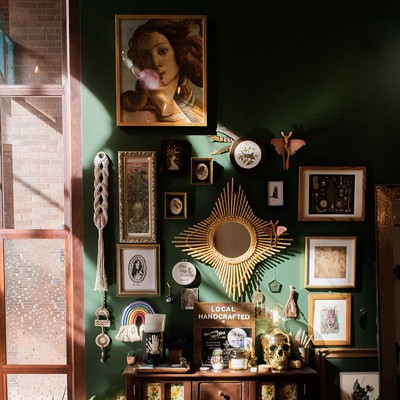Glass artist creates her own Cabinet of Wonders
"Menagerie" by Robin Cass
By Rebecca Rafferty @rsrafferty[
{
"name": "500x250 Ad",
"insertPoint": "5",
"component": "15667920",
"parentWrapperClass": "",
"requiredCountToDisplay": "1"
}
]
Axom Gallery's current show, "Menagerie," featuring flame-worked glass and metal by Robin Cass, explores concepts of capturing life through a fictitious version of the natural wonderland that surrounds us. The body of work is based on the tradition of the Wunderkammern, or cabinet of wonders — old-timey collections of rare natural specimens shown off for bragging rights among wealthy European hobbyists — and of the human need to categorize life. In her stunning sculptural work, Cass takes on not just the identity of a natural wonder hunter, but of the creator of life that might be.
"We have an innate need to investigate the world; to observe, record, collect, and present our discoveries for others to appreciate," Cass says in her provided statement. "The parameters of what is acceptable in terms of collecting, categorizing, and display are constantly shifting depending on cultural context."
The lobby of the space shows off a dozen intaglio vitreographs: prints of a variety of organic pods that resemble illustrations pulled from the pages of a naturalist's notebooks or old life science texts. In the gallery proper, realistic specimens seemingly plucked from humid jungle floors or the driest of deserts are suspended from the ceiling within industrial cages. Others are trapped within wall-mounted domes with fixtures that look like what can be described as nautical bell jars. The key element in each is the light flowing into the storage devices, and passing through the translucent glass that make up the fronds and tubes of the plants.
But are these "plants" vegetable, or animal? A strange sentience seems present in each, particularly the ones that include clusters of bubbly, eye-like structures. Cass titles her fictional creations with names stolen from Latin and mixed with descriptor terms used to describe the components she creates. The defining features are highlighted in these names: "Stigmate paddlepod" is a series of stalks ending in wide, flat vegetation; "Ocular bulbupods with protrusi" has screw-shaped stalks searching for light, and eye-like clear, silvery domes that seem to interpret their surroundings while they act as water reservoirs.
The detail-oriented Cass didn't just blow glass and be finished with it — each specimen is found in a bed of colored, jewel-like, pebbled soil. Jewel-like is a good way to describe all of the work; each piece has a light-suspending sense of luminous preciousness. Even the simple structures seem alive. "Papiculate tri-stigmata," with its few pale elements like the eyestalks of snails, seem to wend toward the light slowly under the viewer's steady eye.
"Ironically, the qualities that animate living organisms are highlighted by captivity and containment," Cass says. "The rigid materials associated with collection and display devices enhance contrasting biological tissue."
Just like in the case of wonder cabinets, the stranger the specimen, the more valued it is. "The most prized specimens in any collection are those that diverge from the norm or defy classification," she says. The works are familiar in their features, yet alien in this particular arrangement of them. The knobby globs of glass that make groups of oculi, the thin stems, and coin-shaped clusters of light-collecting foliage are all elements that might have a place in our world. Here, they are the mad imaginings of a fascinated dreamer.
But the world is wide, and we don't understand the half of it. This is particularly true when it comes to the tiniest parts of life, and those found in the most exotic, hardest to reach arenas of nature. Yet what may seem like an unlikely arrangements of parts — such as the real-life Condylura cristata, a mole with a star-shaped, fleshy appendage on its nose, native to eastern Canada and the northeastern United States — are rendered alien to us because our different realms, by and large, do not come into contact.
And we can no longer ignore that the human impact on this planet is the cause of mass-decimation of the most fragile parts of it. So there is another side to the concept of collecting. As with zoos and other "collections" of natural wonders, there is a depressing irony in the fact that so many creatures are kept in collections in the interest of their protection. Cass's lifelike creations are injected with that same sense of wonder we derive from encountering the strangeness of life's diversity, while they are a foreboding reminder to safeguard creatures out there in this world, before they only exist within cages and under glass.
Speaking of...
-

“Ragtime” evokes history through rhythm and rhyme
May 8, 2023 -

Review: Alan Singer's 'Shapely' at AXOM
Feb 19, 2019 -

Film review: 'Ralph Breaks the Internet'
Nov 27, 2018 - More »
Latest in Art
More by Rebecca Rafferty
-

Beyond folklore
Apr 4, 2024 -

Partnership perks: Public Provisions @ Flour City Bread
Feb 24, 2024 -

Raison d’Art
Feb 19, 2024 - More »







